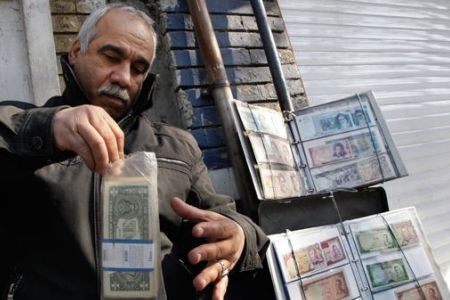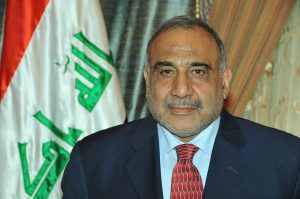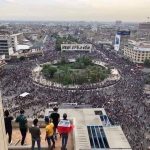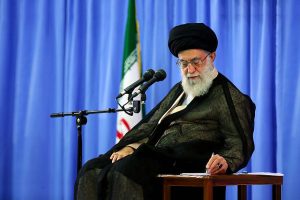By Kevan Harris
via the United States Institute of Peace
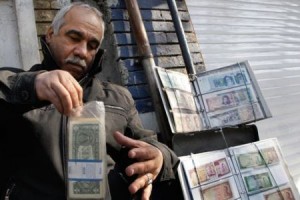 What are the primary reasons that the Iranian rial has lost half of its value against the U.S. dollar in just one year? Iran’s currency was valued at about 10,000 rials to the dollar in the summer of 2011. It plummeted to more than 20,000 to the dollar in the summer of 2012.
What are the primary reasons that the Iranian rial has lost half of its value against the U.S. dollar in just one year? Iran’s currency was valued at about 10,000 rials to the dollar in the summer of 2011. It plummeted to more than 20,000 to the dollar in the summer of 2012.
Inflation in Iran’s economy has not been this bad since the end of the Iran-Iraq War or the economic crisis of the early 1990s, which also caused high inflation. The rial’s value began to slide rapidly at the beginning of 2012 after the United States announced new sanctions above and beyond the latest U.N. sanctions. The slide was due partly to the psychology of sanctions.
In that sense, a certain percentage of the public—and their expectations–helped cause the more rapid slide. They don’t think the Central Bank can stabilize the rial in the medium term. People who have money are buying gold, dollars, and real estate to protect their wealth. Everybody is making individual decisions that are pushing the rial down because everyone is holding onto foreign currencies.
What is the impact on the Iranian public?
With increased sanctions, the demand went up for gold, foreign currency and anything independent of the rial. In fact, the real estate market in Tehran has been growing over the last six months. It had slowed in previous years due to a housing crash just like everywhere else. People are even putting money into real estate in poorer neighborhoods, which means people are continuing to take money out of the banks and invest it in housing.
What has happened in the last six months is very similar to what happened to the Russian middle class in 1999 and Argentine middle class in 2001. The Iranian middle class is going through the same process. They are seeing the value of their money in the bank erode. It is a shock.
After the Russian and Argentine financial crises, both countries ended up with more nationalist leaders in power–Vladimir Putin and Nestor Kirchner. Policymakers in the United States might want to remember that. Financial crises do not always produce what you want or expect.
What is the Iranian government’s response?
The government is trying to respond with various short-term measures. For example, the price of rice has gone up only slightly compared to the price of chicken partly because the government has exchanged oil for stockpiled rice with India. Everybody eats rice in Iran and not everyone can afford chicken, so the government is attempting to prioritize those goods which have the widest consumption.
The government also went back to a tiered currency regime similar to what it had in the 1980s, during the Iraq-Iran War, and through the 1990s. Various types of imports and transactions had different exchange rates. Today, the official exchange rate is used for strategic imports such as food and medicine. That is another reason the price of rice did not go up a lot.
The price of chicken went up a lot, however, because Iran is not a socialist country. It cannot control the price of everything. Chicken farmers and wholesale buyers respond to market prices. The government capped the store price of chicken, but the price of chicken feed was going up because much of it is imported.
Along with cutbacks in subsidies, which also caused domestic inflation, the chicken farmers’ costs became so high that they could not make a profit. So they basically stopped selling. Chicken prices went up drastically because there was no chicken on the market. The government was slow to respond—and then did what it always does. It found a place in the world with something cheap to sell. Iran imported frozen chicken from Latin America, just as it now imports beef from Brazil. Each of the goods has its own story, but the rice-and-chicken dynamic is illustrative of the government’s strategy for dealing with inflationary shocks.
The state also stopped its phased subsidy reductions. It had planned to further cut longstanding subsidies for electricity, gasoline and utilities, but parliament told the president in the spring to continue the current level of subsidies. The president initially refused, but under parliamentary pressure has deferred any new price hikes. So U.S. and E.U. sanctions have forced the Islamic Republic to stop the subsidy reduction program that the International Monetary Fund and the Ahmadinejad government had been working on for years.
What roles have U.S. and international sanctions played in Iran’s currency drama? In July 2012, Parliamentary Speaker Ali Larijani said that only 20 percent of Iran’s economic problems were due to international sanctions. What is your assessment?
It is hard to put a number on what percentage U.S. and E.U. sanctions have on currency devaluation and inflation because both are produced by a combination of factors– what individuals do based on future uncertainty and the sometimes contradictory policies of the government.
The Central Bank has suggested that it may change the official exchange rate. What impact will that have? Will it solve the problem? Are there any side effects or dangers?
Some economists, including many in Iran, say the country needs a single rate. People make money playing the official and unofficial currency rates off each other. But the state does not have the luxury of unifying the rial’s value. So it is trying all sorts of stop-gap measures, which in the long term are harmful. They create opportunities for speculation. But the state, which is dealing in the short term, is in a double bind. Letting the official rate devalue would lead to such an inflationary burst that prices could go up even more.
The other option is what the state is doing now, prioritizing who gets money. It is giving money to strategic sectors and industries that it cannot let slide, like the auto industry, the oil sector and businesses related to petroleum. It gives them the better exchange rate. Yet these are short-term solutions to big problems.
In the 1980s, the government also tried to plan what food and consumer goods came into the country. The government had to basically take over the market, and this is what they are doing again–only for those items or industries that it feels are strategic, like rice, as opposed to chicken. Politically, you cannot have a whole town without rice; it is impossible.
What will happen if the rial continues to lose value?
People will probably continue to “euro-ize” and dollarize their transactions if the value falls. But Iran will always find another country to make a deal with. There is a long list of countries that will pursue their national interests and deal with Iran. The whole world economy is slowing down, so everyone is looking for cheaper deals. There will probably be more smuggling as well, as people turn to the black market for goods which may be in short supply.
Read Kevan Harris’ chapter on the bazaar in “The Iran Primer”
Kevan Harris is a postdoctoral research associate at Princeton University. He is a 2011-12 USIP Jennings Randolph Peace Fellow. He writes a weblog called “The Thirsty Fish.”

